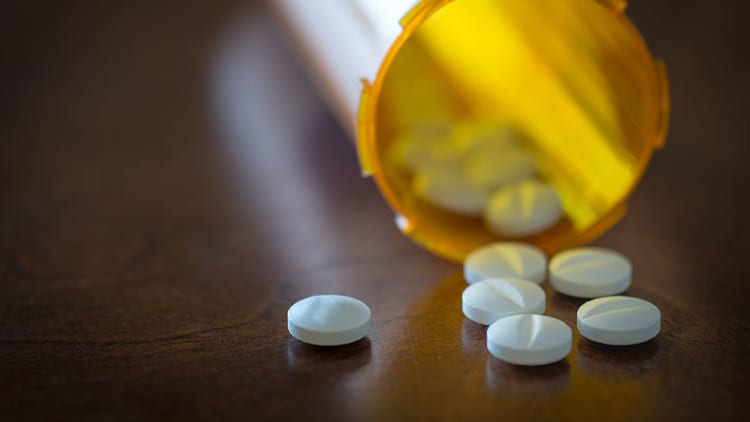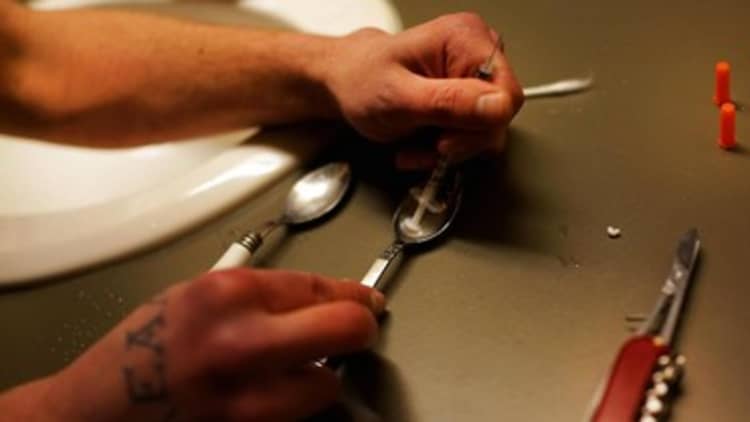
Americans are in more pain than any other population around the world. At least, that's the conclusion that can be drawn from one startling number from recent years: Approximately 80 percent of the global opioid supply is consumed in the United States.
Pain drugs are the second-largest pharmaceutical class globally, after cancer medicines. "There was about 300 million pain prescriptions written in 2015," Irina Koffler, senior analyst, specialty pharma, Mizuho Securities USA, told CNBC.
The 300 million pain prescriptions equal a $24 billion market, Koffler said, but it's not a market evenly divided around the globe. Rampant use of opioids in the United States, which represents only 5 percent of the global population, points to a larger divide between affluent nations and the rest of the world when it comes to prescription painkillers.
"If you include Canada and Western Europe, [consumption of global opioid supply] increases to 95 percent, so the remaining countries only have access to about 5 percent of the opioid supply," said Vikesh Singh, assistant professor of medicine and director of the Pancreatitis Center at Johns Hopkins University.
In most countries, the use of opioid prescriptions is limited to acute hospitalization and trauma, such as burns, surgery, childbirth and end-of-life care, including patients with cancer and terminal illnesses. But in the United States, every adult in America can have "a bottle of pills and then some," U.S. Surgeon General Vivek Murthy has said publicly.
Based on 2015 sales, the top five opioid products were made by Purdue Pharma, Johnson & Johnson, Insys Therapeutics, Mylan and Depomed, according to EvaluatePharma, a life sciences market intelligence firm, which tracks sales.
A Purdue Pharma spokesman said its products represent only 2 percent of all opioid prescriptions, but even so, "we've led the pharmaceutical industry in developing medications with abuse-deterrent properties, and we've long supported the use of prescription-drug monitoring programs, better physician education," and law enforcement access to anti-overdose drugs.
The other pharmaceutical companies did not provide comment by press time.
The 80 percent figure for U.S. consumption has been cited in various studies, including a December 2014 Express Script report. The latest year for which fatality statistics are available is also 2014: 28,000 people died from opioid overdoses, according to the CDC — the highest number on record. More than 14,000 of these deaths were linked to prescription opioids (an increase in this category of 693 since 2013), or roughly 40 deaths per day.
A recent survey by the National Safety Council revealed that about 99 percent of physicians exceed the recommended three-day dosage limit, with a quarter of them writing prescriptions for a full month and thus overprescribing these types of medications.
"The majority of ... these misused prescription opioids are coming from legally written prescriptions," Surgeon General Murthy has said.
When a problem is moving quickly, Congress is always going to be a little bit behind in catching up, but I feel like there's a clear awareness now of how serious this problem really is.Senator Pat Toomey, R-Penn.
The situation is causing politicians, advocacy groups and government organizations to enact stricter measures when it comes to prescribing some of these powerful painkillers.
"When a problem is moving quickly, Congress is always going to be a little bit behind in catching up, but I feel like there's a clear awareness now of how serious this problem really is," said Senator Pat Toomey, R-Penn., in an interview with CNBC.
Americans consume approximately 99 percent of one specific opioid, called hydrocodone, a powerful painkiller. The Drug Enforcement Agency reclassified hydrocodone from a schedule III to a schedule II drug in 2014 because of its potentially high risk for misuse and abuse.
Drugs like Abbvie's Vicodin (a branded version of hydrocodone that commanded 46 percent of the nation's prescription painkiller market in 2013, according to Express Scripts), cannot be administered as freely as they were before; patients now have to bring a physical prescription to a pharmacy in order to get it filled. Abbvie did not respond to a request for comment.
There was a 27 percent decline in sales for hydrocodone from 2013–2015, Koffler told CNBC.
Physicians and lawmakers point to several potential causes as the reasons for the current epidemic. They include doctors who prescribe these medications to patients without fully explaining side effects; payments to physicians from pharmaceutical companies; aggressive marketing by drug companies downplaying addiction risk; and patient advocate groups that insist people with chronic pain get the medications that relieve their symptoms right away.
Painkiller critics have also recently been speaking out against hospital surveys they feel encourage the overprescription of opioids in the hospital and clinical settings. Doctors can receive better survey evaluations based on whether or not they gave a patient the medications they wanted, not necessarily those that suited them best.
Toomey's focus had been on trying to prevent and control what is referred to as "doctor shopping," the practice of using multiple doctors to keep receiving painkiller prescriptions.
"In a single year, about 170,000 Medicare beneficiaries were doctor shopping ... going to multiple doctors to get the same opioid prescriptions and then going to multiple pharmacies and getting them all filled," Toomey told CNBC.
A tool called "Lock-In" is now being used by Medicaid and many private insurers.
It locks the patient into a single doctor and pharmacy so that prescriptions can be tracked more easily. Legislation was recently passed to add Medicare to the Lock-In program, which would save taxpayers around $100 million per year, according to the Government Accountability Office.

The Centers for Disease Control and Prevention recently released new guidelines in terms of prescribing opioids. The recommendations include when to take opioids for chronic pain, selecting appropriate dosage and assessing the risk and harm in opioid use.
A CDC spokesperson told CNBC that the guidelines are not mandated, meaning they are not laws but rather a tool that primary-care providers can use for reference.
It's yet to be seen if stricter guidelines will have an impact on the number of deaths and cases of addiction that result from taking some of these opioids.
Physicians are also turning to a drug called Suboxone, a pill that treats addiction to painkillers; however, some feel that overusing Suboxone could lead to problems of its own.
"Sometimes doctors keep patients on [Suboxone] for two to three years, which is terrible because then we have to wean them away from Suboxone here," said Richard Conaboy, vice president of clinical services at Pennsylvania-based Clearbrook Treatment Centers, which provides care for many patients who are addicted to painkillers.
Conaboy sees a lot of "union people, truck drivers … who started out with pain pills and then stepped down to heroin because the pills became more expensive. They 'stepped down,' which sounds ridiculous, but heroin is less potent than these opioids," he said.
His business is booming. "Job security is something everyone worries about, and we do in this industry as well, but with the epidemic that has taken over," Conaboy said. "I don't think we're going to see it slow down for a long, long time."



